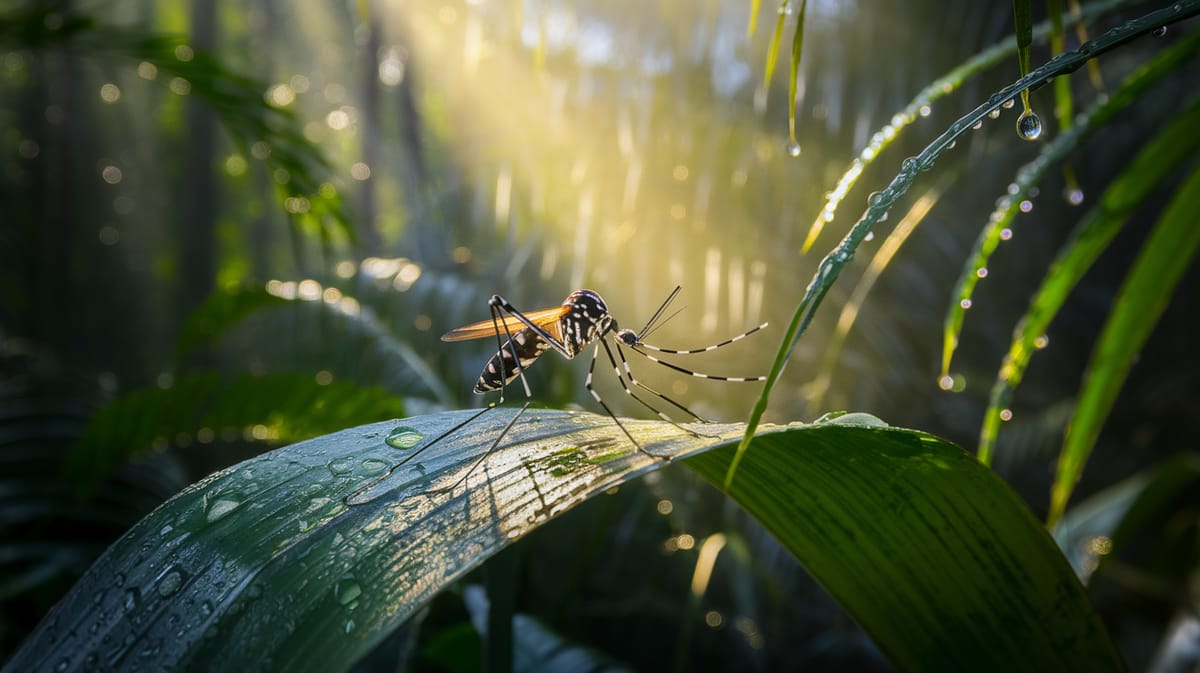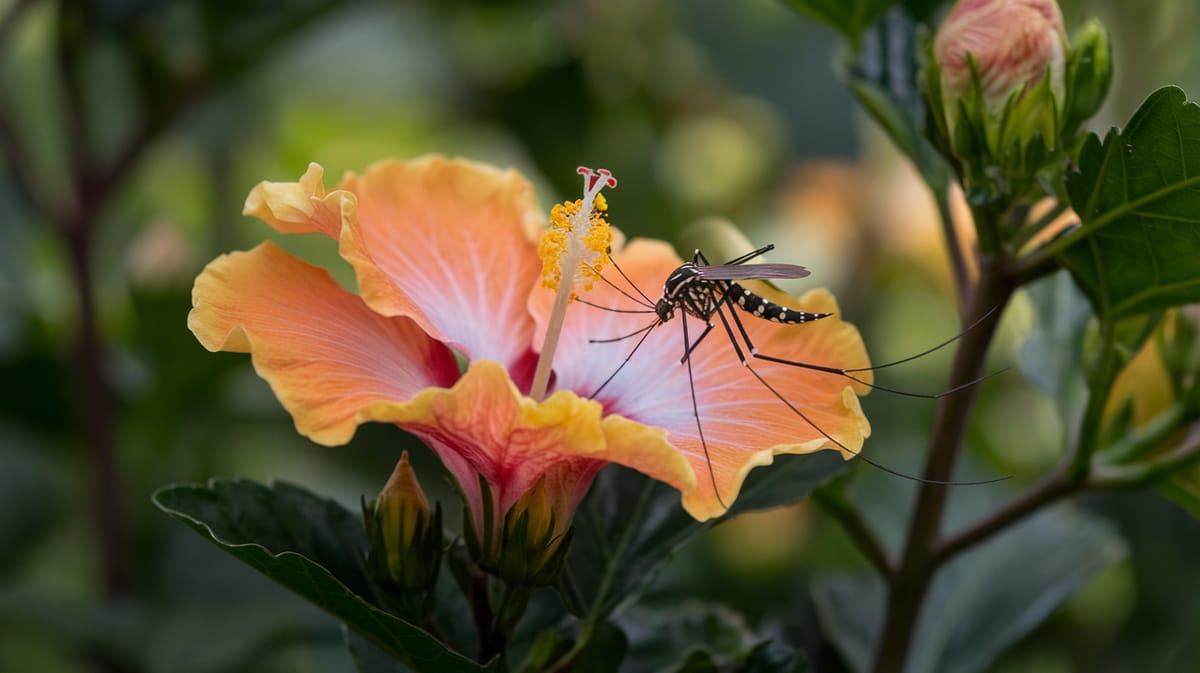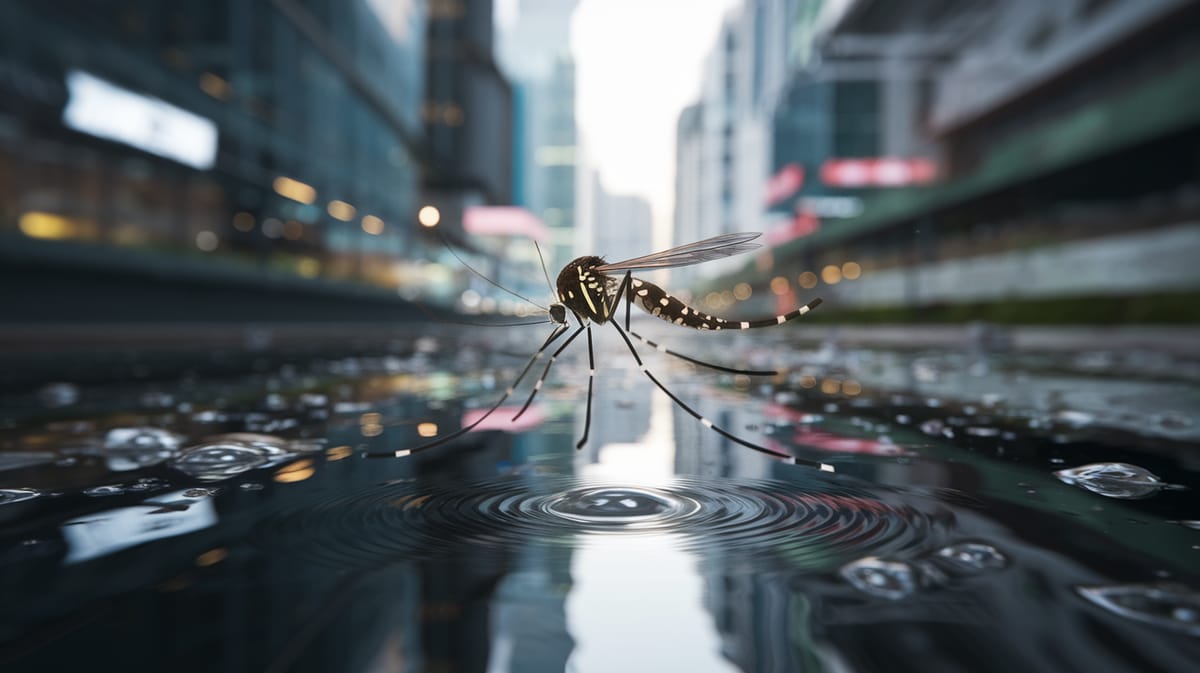Asian Tiger Mosquito
Striped elegance meets biting tenacity, the Asian Tiger Mosquito thrives in urban landscapes. Known for its aggressive daytime biting, it poses significant health challenges worldwide.

Key Insights at a Glance
Did You Know?
Taxonomy & Classification
The Asian Tiger Mosquito, known for aggressive daytime biting and distinctive black-and-white striped body, thrives in urban environments, showing adaptability to various climates. Let's understand the evolutionary journey and classification of these remarkable parasites.
Global Spread
Native to Southeast Asia, Aedes albopictus has expanded to over 40 countries, becoming a global vector for diseases like dengue and chikungunya.
Adaptive Evolution
Evolving from the tropical forests of Asia, it adapted to temperate climates, surviving cold winters and thriving in urban settings worldwide.
Lifecycle and Growth
A remarkable journey of transformation from Egg to Adult.
Egg
Laid on moist surfaces, eggs can survive dry conditions until submersion triggers hatching into larvae.
Larva
Larvae, or wrigglers, feed on organic matter in water while undergoing four molts to grow.
Pupa
Pupae, known as tumblers, do not feed but transform inside their cases, preparing for adult emergence.
Adult
Adults emerge to mate and females seek blood meals necessary for egg production, ensuring species propagation.
Dietary Habits
A persistent feeder with specialized adaptations, this insect targets vertebrate hosts, focusing on blood meals for reproduction.
| DIET TYPE | DESCRIPTION |
|---|---|
| Primary Diet | Primarily feeds on human blood, using its proboscis to pierce skin and extract nutrients. |
| Secondary Diet | Consumes the blood of other mammals, birds, and sometimes reptiles, adapting to host availability. |
| Occasional | Occasionally feeds on plant nectar, especially when vertebrate hosts are scarce, to supplement energy needs. |

Behaviour and Adaptations
Discover the fascinating traits that make the Asian Tiger Mosquito a formidable insect.
Aggressive Feeding
Prefers feeding during daylight, increasing its chances of finding hosts.
Rapid Breeding
Quick reproductive cycles enable swift population growth and spread.
Adaptable Habitat
Thrives in diverse environments, from urban areas to forests.
Ecosystem Impact
Understanding how the Asian Tiger Mosquito contributes to ecological balance.
Pollination Assistance
Helps in pollinating various plant species, aiding in plant reproduction.
Food Source
Serves as an essential food item for birds, bats, and other insects.
Genetic Diversity
Promotes genetic variation by facilitating cross-pollination among plant populations.
Conservation Challenges
Addressing the major threats to Asian Tiger Mosquito populations.
Habitat Loss
Urban development reduces breeding sites, impacting mosquito survival.
Climate Change
Altered rainfall patterns affect mosquito distribution and breeding.
Chemical Exposure
Insecticides disrupt mosquito populations and ecosystems.
Frequently Asked Questions
How long do Asian Tiger Mosquito live?
Asian Tiger Mosquitoes typically live for two to four weeks, depending on environmental conditions like temperature and humidity. Their lifecycle includes egg, larva, pupa, and adult stages, with adult females living longer than males due to their role in reproduction.
What do Asian Tiger Mosquito eat?
Adult Asian Tiger Mosquitoes feed on plant nectar and fruit juices for energy. Female mosquitoes also require blood meals to develop eggs, often biting humans and animals. The larvae feed on organic matter and microorganisms in water.
Are Asian Tiger Mosquito poisonous?
Asian Tiger Mosquitoes are not poisonous. However, they are vectors for diseases like dengue, chikungunya, and Zika viruses. Their bite can cause itching and irritation but does not deliver venom.
Are Asian Tiger Mosquito endangered?
Asian Tiger Mosquitoes are not endangered. They are widespread and considered invasive in many regions outside their native range in Southeast Asia, including parts of Europe and the Americas. Their adaptability and reproductive capabilities contribute to their thriving populations.
What do Asian Tiger Mosquito symbolize?
Asian Tiger Mosquitoes do not have a strong symbolic significance in culture. They are often associated with health concerns due to their role in transmitting diseases and are seen as pests affecting outdoor activities and well-being.
Do Asian Tiger Mosquito bite?
Yes, female Asian Tiger Mosquitoes bite to obtain blood necessary for egg development. They are aggressive daytime feeders and prefer biting humans but will also bite animals. Their bites can cause discomfort and potential disease transmission.
What color are Asian Tiger Mosquito?
Asian Tiger Mosquitoes have a distinct black and white pattern. They feature black bodies with white stripes, including a prominent white stripe running down the center of their back, making them easily recognizable.
Does a Asian Tiger Mosquito have wings?
Yes, Asian Tiger Mosquitoes have wings. Like all mosquitoes, they possess one pair of wings that enable them to fly, seeking food sources and breeding sites. Their wings are essential for dispersal and survival.
What does a Asian Tiger Mosquito look like?
Asian Tiger Mosquitoes are small, about 2-10 mm long. They have a striking black body with white stripes on their legs and a single white stripe down their thorax. Their distinct pattern makes them easily identifiable compared to other mosquito species.
Is a Asian Tiger Mosquito an insect?
Yes, the Asian Tiger Mosquito is an insect. It belongs to the order Diptera, characterized by having a single pair of wings. They are part of the Culicidae family, known for their role as disease vectors and their characteristic biting behavior.
Related Insects
Discover insects with similar characteristics to Asian Tiger Mosquito - including shared habitats, diets, and taxonomic classifications
Share this profile
Help others discover Asian Tiger Mosquito
